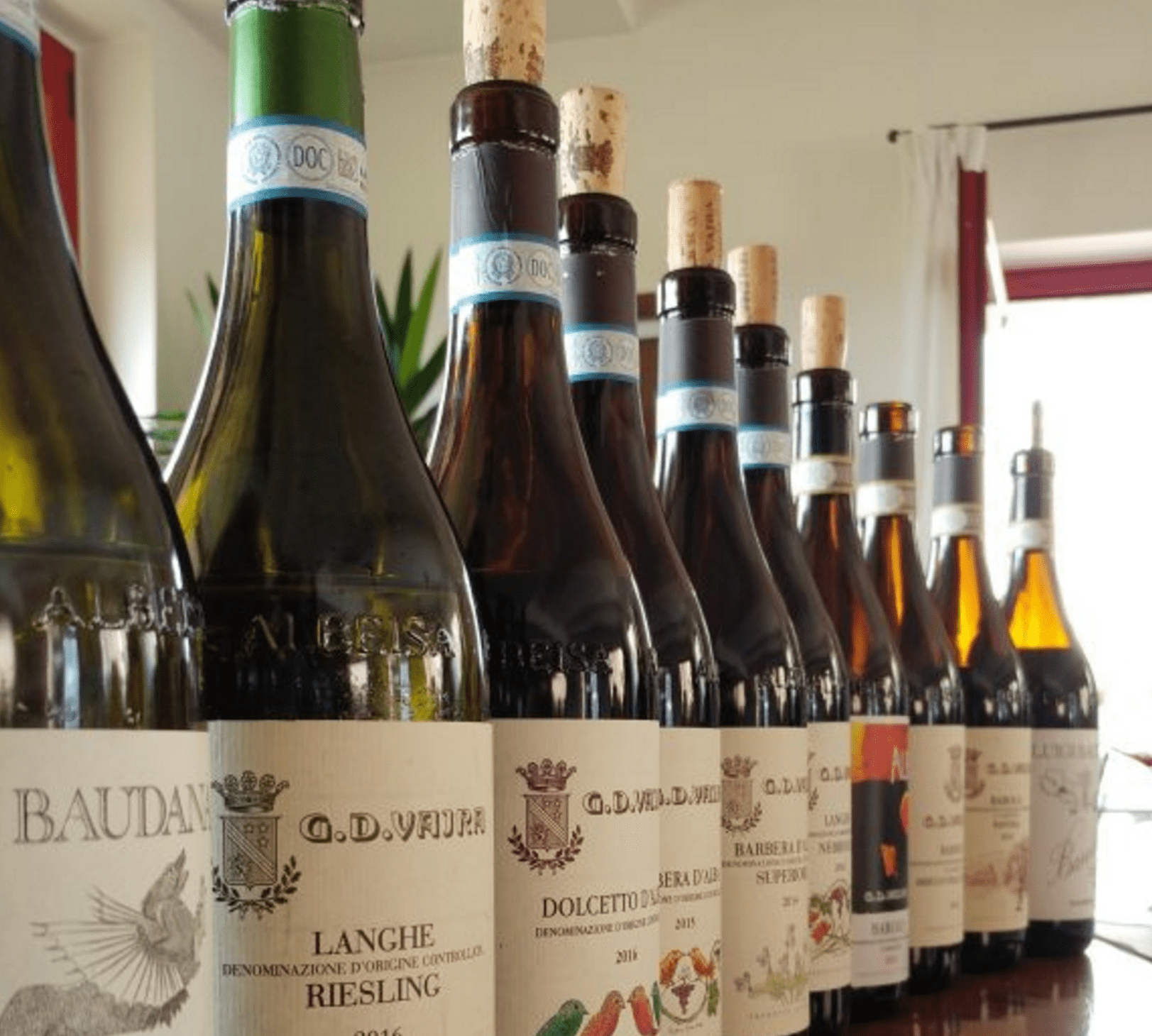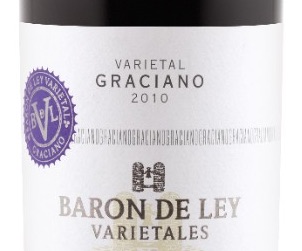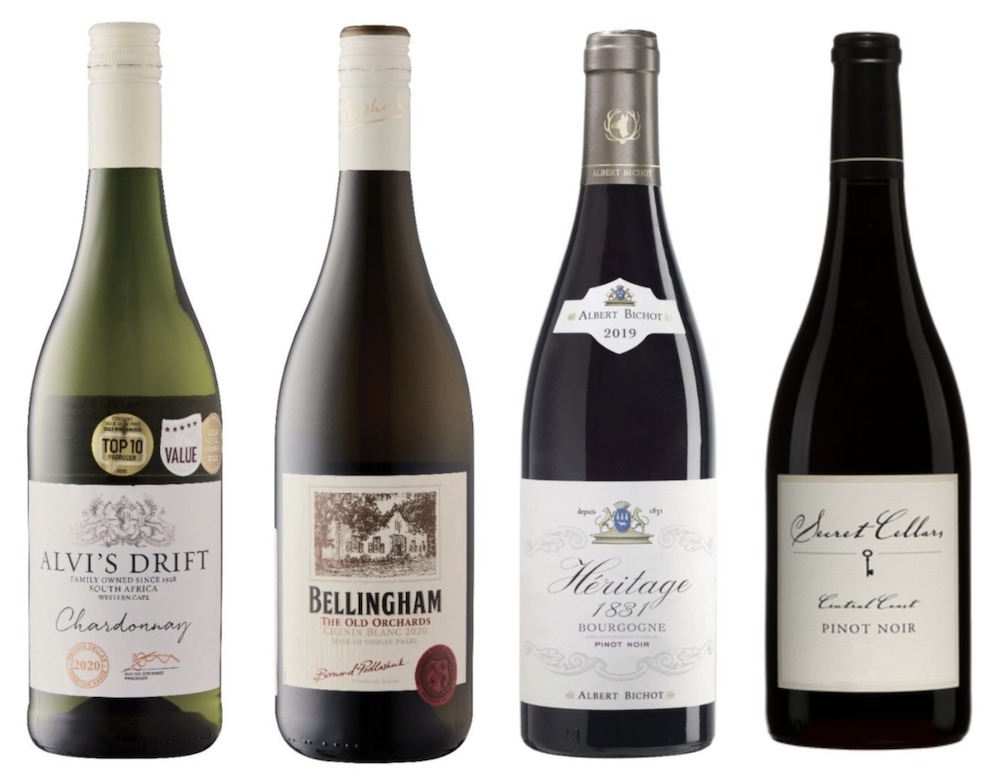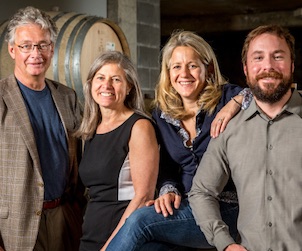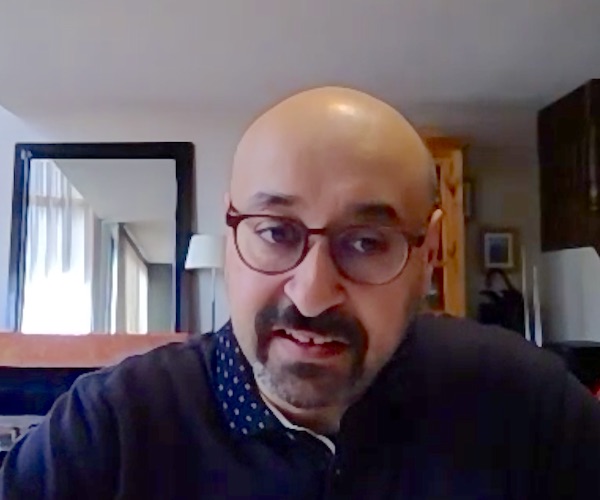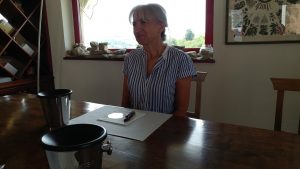
Milena Vaira in the tasting room.
I sat down with Milena Vaira of Azienda Agricola G.D. Vajra and Robert Miller of The Vine Agency one morning in the tasting room of Vajra overlooking the hill of Bricco Della Viole in the town of Vergne, a five-minute drive west of the town of Barolo. We were joined later by Milena’s daughter Francesca. Milena’s English isn’t as good as Francesca’s but my Italian is virtually non-existent so, thankfully, before Francesca arrived, Milena’s graciousness superseded whatever language barrier we faced.
The discrepancy between the family name “Vaira” and the winery name “Vajra” stems from a printing error when the winery first opened in 1972 which made the “I” look like a “j” on the logo. Since the original spelling of the family name was Vajra up until 1918 when the letter “j” was eliminated from Italian except for foreign words, the family decided to keep the old spelling to distinguish the winery name from the family name.
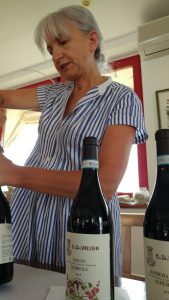
Robert and I tasted through a range of wines, all excellent, but one stuck out because of the story which accompanied it. Before Francesca arrived, Milena related the story of the “Albe” Barolo. “Albe” is made from a blend of three crus or MGAs (Menzioni Geografiche Aggiuntive, loosely translated as Additional Geographical Definitions), which surround the Vajra home atop the Bricco Della Viole MGA. There are 170 official MGAs in Barolo DOCG, introduced September 30th, 2010; some very large, like Bussia which encompasses many aspects and slopes, and others, like Bricco delle Viole, which delimit a single hill. The Bricco delle Viole, ‘the Violet Hill’, so-named because in spring it is covered in violets, lies within the western portion of the Barolo DOCG in the commune of Barolo and is one of the most highly-regarded MGAs as well as the highest vineyard in the commune with G.D.Vajra the acknowledged leader of the cru.
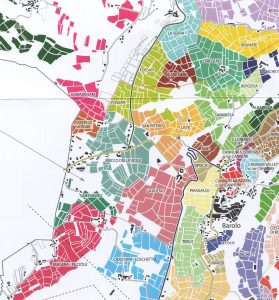
Map of the western MGAs of the Barolo commune by Masnaghetti
A half-hour’s drive to the northeast is the town of Alba, which centers this part of Piemonte. ‘Alba’, in the local Piemontese dialect, means sunrise and ‘Albe’ is its plural. The G.D. Vajra “Albe” Barolo 2013 is made from the three MGAs, Fossati, Coste di Vergne, and La Volta, to the northeast, northwest, and southeast, respectively, of Bricco delle Viole. Over the shoulders of these sloping hills, the dawn takes about 20 minutes to reach each vineyard, creating three different dawns or ‘albe’.
The label for “Albe” is distinct from Vajra’s other labels and features a painting depicting these multiple sunrises. The story which accompanies this label is as humourous as it is enlightening. One evening, Milena and her family hosted the famous artist and stained-glass maker, Father Costantino Ruggeri, a long-time family friend. Father Ruggeri’s gorgeous stained-glass windows hang in the Vajra winery, and are a constant reminder for those making the Vajra wine of art and beauty.
To honour the occasion, Milena brought out her finest china, plates, cutlery, and tablecloth. After finishing a classic tomato sauce dish, the guest of honour confessed that he had always fantasized about taking his finger and scooping up some sauce and painting upon the perfect white of a tablecloth. Milena froze. “We are farmers, and this tablecloth was one of our most prized possessions.” Thankfully, he did not follow through on his daydream, but Milena thought later about this yearning for artistic expression versus the preciousness of a family heirloom. It dawned on her that she should ask Father Ruggeri if he would paint the label for their new wine, a wine meant to transgress upon the perceived preciousness of some Barolo wines.
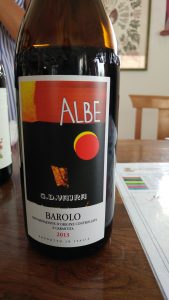
“Albe” is conceived as a gateway Barolo, the Barolo you introduce to people who have not yet discovered its sublime pleasures. It is a wine meant to be enjoyed, not revered or preserved, like the Vajra family tablecloth, but painted upon with a day-dreaming finger coated in tomato sauce. A wine meant to be drunk now, with friends and family. “Albe” is a traditional wine, made by one of the area’s traditional wine families, to be enjoyed without caring too much about drawing on cherished objects.
As a wine, Barolo DOCG tends to command money and respect, if not outright reverence. The very fact that many of these wines only hit their stride decades on reinforces this reverence. Indeed, Barolo could stand in for any long-lived wine with a price tag. But what “Albe” teaches us is not to revere these wines so much that we miss entirely the point, the pleasure in the glass.
2013 G.D. Vajra ‘Albe’ Barolo DOCG, Piedmont, Italy
Youthful, fresh aromas of morello cherry, wild violet, dried sage, freshly-turned earth and new leather. Long maceration and 75hl cask aging give this wine high, fine and compact tannins which are approachable now but will fully resolve with a decade of further bottle age. The wine is harmonious on the palate, the bright red fruit seamlessly integrated with the 14% alcohol; the tight structure will successively open after some decanting and in the glass. An elegant multi-cru Barolo, perfect now with tomato-based dishes, in a few years with the classic Piemontese dish, Agnolotti del Plin, or by itself to convince a friend of the beauty to be found in these hills.
![]()
(Four and a half apples out of a possible five)
 Christopher Wilton lives in Peterborough and is a wine sales representative for the Small Winemakers Collection, a wine educator at Durham College, a server, and the regional liaison on the CAPS board of directors. He is certified with CMS, is almost finished his WSET Diploma, and has his CSW.
Christopher Wilton lives in Peterborough and is a wine sales representative for the Small Winemakers Collection, a wine educator at Durham College, a server, and the regional liaison on the CAPS board of directors. He is certified with CMS, is almost finished his WSET Diploma, and has his CSW.

